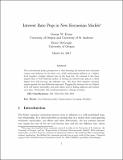Interest rate pegs in New Keynesian models
Abstract
The conventional policy perspective is that lowering the interest rate increases output and inflation in the short run, while maintaining inflation at a higher level requires a higher interest rate in the long run. In contrast, it has been argued that a Neo‐Fisherian policy of setting an interest‐rate peg at a fixed higher level will increase the inflation rate. We show that adaptive learning argues against the Neo‐Fisherian approach. Pegging the interest rate at a higher level will induce instability and most likely lead to falling inflation and output over time. Eventually, this would precipitate a change of policy.
Citation
Evans , G W & McGough , B 2018 , ' Interest rate pegs in New Keynesian models ' , Journal of Money, Credit and Banking , vol. 50 , no. 5 , pp. 939-965 . https://doi.org/10.1111/jmcb.12523
Publication
Journal of Money, Credit and Banking
Status
Peer reviewed
ISSN
0022-2879Type
Journal article
Description
Financial support from National Science Foundation Grant No. SES-1559209 is gratefully acknowledged.Collections
Items in the St Andrews Research Repository are protected by copyright, with all rights reserved, unless otherwise indicated.

